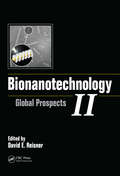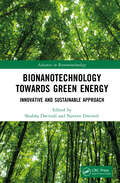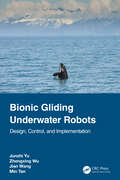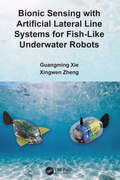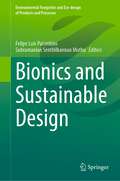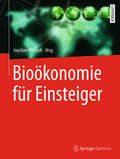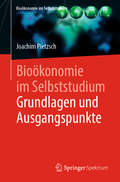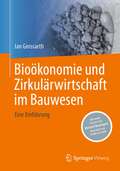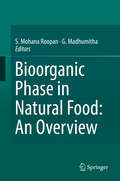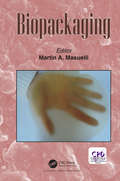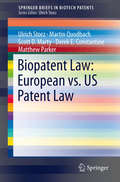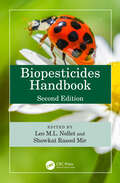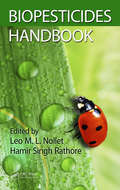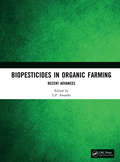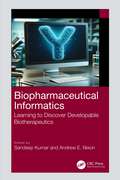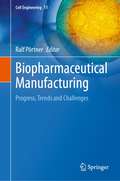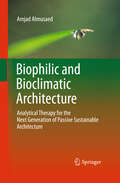- Table View
- List View
Bionanotechnology: Global Prospects
by David E. ReisnerAs the impact and importance of nanotechnology continues to grow, nanomedicine and biotechnology have become areas of increased development. Drug delivery by nanoparticulates and nanocoatings for medicial devices are among the many new techniques on the horizon. Years from now we will laugh at the approaches to treating disease we currently conside
Bionanotechnology for Advanced Applications (Advances in Bionanotechnology)
by Ajaya Kumar Singh Bhawana JainThis book provides the fundamental aspects of bionanomaterials and bionanotechnology, and insight into the synthesis and modification of bionanomaterials in a detailed manner. It initiates with a general overview of biotechnology and nanotechnology followed by different strategies and methodologies for the synthesis of nanomaterials. Further, it discusses pertinent topics such as protein engineering, analysis, mechanisms of microbe- mediated nanosynthesis, followed by various challenges and innovation strategies, and the role of enzymes in bionanotechnology.Features: Covers the synthesis of bionanomaterials, including the interaction between nanomaterial and biogenic materials Encompasses the study of the connections between structure, molecular biology, and nanotechnology Explains several techniques (XRD, SEM, TEM, etc.) used for the analysis of bionanomaterials Includes prospects, challenges, and opportunities associated with bionanotechnology Reviews the interaction between nanomaterials and the biological system and self- assembly in bionanotechnology This book is aimed at graduate students and researchers in materials sciences, biotechnology, and bionanotechnology.
Bionanotechnology II: Global Prospects
by David E. ReisnerThe impact and importance of nanotechnology continues to grow, and nanomedicine and biotechnology have become areas of increased development. Biomedical engineers who work with biological processes and structures must have a deeply rooted understanding of the role of bionanotechnology, a rapidly evolving sector of the nanotechnology field. Bionanot
Bionanotechnology Towards Green Energy: Innovative and Sustainable Approach (Advances in Bionanotechnology)
by Shubha Dwivedi and Naveen DwivediBionanotechnology Towards Green Energy explains the role of bionanotechnology in the next generation technologies of green energy from an interdisciplinary and sustainability perspective. Chapters cover different roles of bionanotechnology such as applications of bio-nano enabled materials/coatings, scaling-up of green energy production, design and synthesis of bio-inspired nanomaterials and their applications, bio-nanofluid-based photovoltaic thermal systems, the use of bio-templated and biomimetic materials, and so forth. It focuses on waste-to-energy conversion and fixing intricate environmental issues. Key features: Provides detailed coverage of green energy production through bionanotechnological intervention Reviews future research needs in bionanotechnology in the green energy sector and scientific challenges in the mitigation of energy crises Deals with cutting-edge research on microbial synergism in biohydrogen production and storage Discusses the fabrication of bio-nano/hybrid electrode materials for supercapacitors and energy storage devices Includes extensive illustrations, case studies, summary tables, and up-to-date references This book is aimed at researchers and professionals in bionanotechnology, energy sciences, and environmental engineering.
Bionanotechnology Towards Sustainable Management of Environmental Pollution (Advances in Bionanotechnology)
by Naveen Dwivedi Shubha DwivediThis book highlights the characteristics, aims, and applications of bionanotechnology as a possible solution for sustainable management and bioremediation of environmental pollutants. It covers remediation of toxic pollutants, removal of emerging contaminants from industrial wastewater, eco-design and modification study of bio-nanoparticles and life-cycle assessment, nano-filtration, bio-nanomaterials based sensors for monitoring air and water pollution, resource recovery from wastewater, and highlights Internet of things-based green nanotechnology.Provides a comprehensive solution of environmental problems in sustainable and cost-effective modeReviews bionanotechnological applications in nanomaterials design, modification, and treatment of emerging contaminants from industrial wastewater.Covers Eco-design study of bio-nanomaterials, bio-nano filters, and assessment for the treatment of emerging pollutantsIncludes IoT- based bionanotechnologyExplores future research needs on bionanotechnology and scientific challenges in the mitigation of environmental pollutantsThis book is aimed at researchers, professionals, and graduate students in nanobiotechnology, environmental engineering, biotechnology.
Bionic (Scholastic Press Novels)
by Suzanne WeynMira has always almost had it all... until it all crashes and burns. She's hurt in a horrible car accident, and the only way the doctors can help is to try experimental prosthetics and chips that are implanted directly into her brain. It's a huge risk, but after months of testing and therapy, Mira is back, and better than ever. But soon her friends turn against her as their parents call her on unfair advantages and get her cut from lacrosse and the scholarships she was depending on for college. And with her enhanced hearing, she knows how many people in her school and her town are calling her a robot, a cyborg. Is that true? Is Mira human, or is she somehow something other? How can she overcome the ways people see her and just be herself... especially if she's not really sure who that is anymore? Suzanne Weyn is always at the cutting edge when it comes to new tech and the questions it raises about the world we live in.
Bionic Bling
by Rachel CraftArtificial replacement joints have to be tough and extra smooth. That’s why doctors use replacement joints made with the same long-lasting and strong stuff as sapphires and rubies, a natural mineral called alumina. Learn more about why this gemstone is perfect for making new joints!
Bionic Functional Structures by Femtosecond Laser Micro/nanofabrication Technologies (Springer Theses)
by Guoqiang LiThis thesis combines advanced femtosecond laser micro/nanofabrication technologies and frontier bionic design principles to prepare diverse biomimetic micro/nanostructures to realize their functions. By studying the formation mechanism of the micro/nanostructures, the author identifies various artificial structural colors, three-dimensional micro/nanocage arrays, and fish-scale inspired microcone arrays in different processing environments. Multiple functions such as enhanced antireflection, hydrophobicity, and underwater superoleophobicity are achieved by precisely adjusting laser-machining parameters. This novel design and method have extensive potential applications in the context of new colorizing technologies, microfluidics, microsensors, and biomedicine.
Bionic Gliding Underwater Robots: Design, Control, and Implementation
by Junzhi Yu Zhengxing Wu Jian Wang Min TanUnderwater robots play a significant role in ocean exploration. This book provides full coverage of the theoretical and practical aspects of bionic gliding underwater robots, including system design, modeling control, and motion planning. To overcome the inherent shortcomings of traditional underwater robots that can simultaneously lack maneuverability and endurance, a new type of robot, the bionic gliding underwater robot, has attracted much attention from scientists and engineers. On the one hand, by imitating the appearance and swimming mechanisms of natural creatures, bionic gliding underwater robots achieve high maneuverability, swimming efficiency, and strong concealment. On the other hand, borrowing from the buoyancy adjustment systems of underwater gliders, bionic gliding underwater robots can obtain strong endurance, which is significant in practical applications. Taking gliding robotic dolphin and fish as examples, the designed prototypes and proposed methods are discussed, offering valuable insights into the development of next-generation underwater robots that are well suited for various oceanic applications. This book will be of great interest to students and professionals alike in the field of robotics or intelligent control. It will also be a great reference for engineers or technicians who deal with the development of underwater robots.
Bionic Optimization in Structural Design: Stochastically Based Methods to Improve the Performance of Parts and Assemblies
by Rolf Steinbuch Simon GekelerThe book provides suggestions on how to start using bionic optimization methods, including pseudo-code examples of each of the important approaches and outlines of how to improve them. The most efficient methods for accelerating the studies are discussed. These include the selection of size and generations of a study's parameters, modification of these driving parameters, switching to gradient methods when approaching local maxima, and the use of parallel working hardware. Bionic Optimization means finding the best solution to a problem using methods found in nature. As Evolutionary Strategies and Particle Swarm Optimization seem to be the most important methods for structural optimization, we primarily focus on them. Other methods such as neural nets or ant colonies are more suited to control or process studies, so their basic ideas are outlined in order to motivate readers to start using them. A set of sample applications shows how Bionic Optimization works in practice. From academic studies on simple frames made of rods to earthquake-resistant buildings, readers follow the lessons learned, difficulties encountered and effective strategies for overcoming them. For the problem of tuned mass dampers, which play an important role in dynamic control, changing the goal and restrictions paves the way for Multi-Objective-Optimization. As most structural designers today use commercial software such as FE-Codes or CAE systems with integrated simulation modules, ways of integrating Bionic Optimization into these software packages are outlined and examples of typical systems and typical optimization approaches are presented. The closing section focuses on an overview and outlook on reliable and robust as well as on Multi-Objective-Optimization, including discussions of current and upcoming research topics in the field concerning a unified theory for handling stochastic design processes.
Bionic Sensing with Artificial Lateral Line Systems for Fish-Like Underwater Robots
by Guangming Xie Xingwen ZhengIn this book, the authors first introduce two fish-like underwater robots, including a multiple fins-actuated robotic fish and a caudal fin-actuated robotic fish with a barycenter regulating mechanism. They study how a robotic fish uses its onboard pressure sensor arrays based-ALLS to estimate its trajectory in multiple locomotions, including rectilinear motion, turning motion, ascending motion, and spiral motion. In addition, they also explore the ALLS-based relative position and attitude perception between two robotic fish in a leader-follower formation. Four regression methods—multiple linear regression methods, support vector regressions, back propagation neural networks, and random forest methods—are used to evaluate the relative positions or attitudes using the ALLS data. The research on ALLS-based local sensing between two adjacent fish robots extends current research from one individual underwater robot to two robots in formation, and will attract increasing attention from scholars of robotics, underwater technology, biomechanics and systems, and control engineering.
Bionics and Sustainable Design (Environmental Footprints and Eco-design of Products and Processes)
by Felipe Luis Palombini Subramanian Senthilkannan MuthuThis book includes both theoretical conceptualization and practical applications in the fields of product design, architecture, engineering, and materials. The book aimed to inspire scholars and professionals to look at nature as a source of inspiration for developing new project solutions. Moreover, being one of the literature’s first direct associations of bionics with sustainability, the book can be used as a reference for those who seek to know more about the theory of bioinspired applications, as well as new technologies, methods, materials, and processes.
Bioökonomie für Einsteiger
by Joachim Pietzsch Stephan Meyer Wolfgang Zettlmeier Ulrich SchurrDieses Buch bietet eine aktuelle und gut lesbare Einführung in die Bioökonomie. Es vermittelt damit grundlegende Kenntnisse zum Verständnis eines Transformationsprozesses, der das 21. Jahrhundert prägen wird und die Integration vieler Disziplinen und Branchen verlangt, die bisher wenig miteinander zu tun hatten. Die Rede ist von dem allmählichen und notwendigen Übergang aus dem Zeitalter fossiler Brennstoffe, das vor rund 200 Jahren begann, in eine weltweite Wirtschaftsform, die auf nachwachsenden Rohstoffen (und erneuerbaren Energien) basiert. Dieses Buch begreift die Verwirklichung von Bioökonomie(n) dabei als eine dreifache Herausforderung – eine naturwissenschaftliche, eine ökonomische und eine ökologische. Woher stammt die Biomasse, die wir vorrangig für die Ernährung der wachsenden Weltbevölkerung wie auch für eine zukünftige energetische und stoffliche Nutzung brauchen? Wie wird sie in Bioraffinerien verarbeitet und welche Rolle kommt der Biotechnologie zu? Welche Gesichtspunkte der Innovationsökonomie gilt es zu bedenken, welche betriebswirtschaftlichen Aspekte der Wertschöpfung, Wettbewerbsfähigkeit und Kundenakzeptanz sind von Bedeutung? Welche Bedingungen muss die Bioökonomie erfüllen, um eine nachhaltige Entwicklung der Erde zu ermöglichen? Darf sie überhaupt auf Wachstumsziele setzen oder sollte sie sich nicht besser am Ideal der Suffizienz orientieren? Indem das Buch diese Fragen aus den nicht widerspruchsfreien Perspektiven ausgewiesener Experten behandelt, gibt es einen interdisziplinären Überblick über ein dynamisches Feld von Forschung und Praxis, der mehr Fragen aufwirft als beantwortet und dennoch eine Lücke schließt. Denn bisher gibt es keine verständliche und fachübergreifende Darstellung der Bioökonomie. Das macht die Lektüre dieses Buches zu einem Gewinn nicht nur für Einsteiger, sondern auch für Fachleute, die über die Grenzen ihres eigenen Fachgebietes hinausschauen wollen.
Bioökonomie im Selbststudium: Grundlagen und Ausgangspunkte (Zertifikatskurs Bioökonomie)
by Joachim PietzschDieses Studienheft ist ein Teil des Springer Zertikfikatskurses Bioökonomie und wird als Material zum Selbstlernen eingesetzt.Historische Einordnung | Entstehung des Begriffs Bioökonomie | Verschiedene politische Strategien der Bioökonomie| Bioökonomie und Nachhaltigkeit | Kaskadennutzung und Kreislaufwirtschaft| Profilierte Bioökonomie-Regionen in Deutschland | Gesetzliche Rahmenbedingungen | Die sieben Herausforderungen der Bioökonomie | Vorstellung beispielhafter Produkte | Fallstudien
Bioökonomie und regionaler Strukturwandel: Wertschöpfung, Innovation und Nachhaltigkeit planen und umsetzen (SDG - Forschung, Konzepte, Lösungsansätze zur Nachhaltigkeit)
by Angela-Verena Hassel Daniel Schiller Stefan Seiberling Christian Theel Steffen FleßaBioökonomie ist eine neue branchenübergreifende Form des Wirtschaftens, die das Potenzial hat, die bisherige Ökonomie und einzelne Regionen grundlegend zu verändern. Dieser Überzeugung folgend stellen die Herausgeber und Autoren dieses Buches den aktuellen Wissenstand aus Theorie und Praxis der Bioökonomie zusammen, entwickeln neue Methoden für einen bioökonomischen Strukturwandel und reflektieren bestehende Bioökonomiekonzepte. Der komplexe und vielschichtige Prozess einer pflanzenbasierten Bioökonomie in ländlichen Räumen wird aus unterschiedlichen Perspektiven betrachtet. Zunächst werden ökonomische Grundlagen sowohl aus gesamt- als auch aus einzelwirtschaftlicher Sicht diskutiert. Dem schließen sich Beispiele an, wie regionale Innovationsnetzwerke und Wertschöpfungsketten der Bioökonomie einen Beitrag zur nachhaltigen Regionalentwicklung und zum gesellschaftlichen Wandel leisten können. Die darauf aufbauende Analyse legt dar, wie verschiedene Akteure und Prozesse eine regionale Bioökonomie in der Praxis etablieren können. Ausgewählte Anwendungs- und Umsetzungsbeispiele für Innovationen pflanzenbasierter Bioökonomie im nordöstlichen Mecklenburg-Vorpommern runden das Buch ab und zeigen das Potenzial für eine Transformation der Wirtschaft in der Region und darüber hinaus.
Bioökonomie und Zirkulärwirtschaft im Bauwesen: Eine Einführung
by Jan GrossarthDas Bauwesen sucht neue Wege. Ein intelligenterer Umgang mit Materialien wie Ziegeln, Stahl, Beton oder Holz ist notwendig. Techniken und Konzepte dafür gibt es. Aber die Umsetzung bleibt träge. Die Gründe dafür sind nicht allein technischer und ökonomischer Art. Auch die sozial- und kulturwissenschaftliche Perspektive auf Akteure, Institutionen und ökologische Krisenwahrnehmungen ist aufschlussreich.Wie lässt sich ein auf Ressourcenbewahrung und Klimaschutz ausgerichteter Bau verwirklichen? Welche Beiträge leisten Zertifizierungen, Ökobilanzierung und die Kommunikation? Was ist von innovativen Zementen oder Recycling-Baustoffen zu erwarten? Und von Nachwachsenden Rohstoffen wie Holz oder Stroh? Welche Beiträge können der politische Ordnungsrahmen und die Werte nachhaltiger Architektur - Ästhetik, Charakter, Geschichtlichkeit - leisten? Wie sind Ziel- und Interessenkonflikte zu beschreiben? Der Ansatz der Bioökonomie verbindet die Idee zirkulärer Stoffströme mit ökonomischem Realitätssinn. Dieses Buch gibt einen Überblick, der von historischen Vorbildern bis zu biotechnologischen Innovationen reicht. Es führt erstmals Ansätze der Bioökonomie und Zirkulärwirtschaft mit der Nachhaltigkeitsausrichtung des Bauwesens zusammen und ordnet sie in handlungsrelevante Kontexte ein. Mit mehreren Exkursionen, und Experteninterviews mit Armin Grunwald und vielen anderen. Sowie einem Vorwort von Michael Braungart: „Unsere Nachhaltigkeits-Expertokratie hilft, das Verkehrte zu optimieren. Zugleich gibt es aber auch gute Entwicklungen.“Das Buch richtet sich an Leserinnen und Leser aus den Bereichen Bauingenieurwesen, Baupraxis, Architektur, Immobilien, Bioökonomie, sowie an Studierende, interessierte Laien und an Akteure der Politik und Politikberatung.
Bioorganic Phase in Natural Food: An Overview
by G. Madhumitha S. Mohana RoopanThe focus of this singular work is to discuss the role and importance of bioorganic phase in food products-providing the first major reference source for researchers looking to understand all aspects of the isolation, extraction and application of this major element in natural foods. From the identifying features to its applications through biotechnology and nanobiotechnology, this book covers all of the important aspects of bioorganic phase and points to future uses and methods. With chapters focusing on phase extraction and application, food product synthesis and nanoparticle application, Bioorganic Phase in Natural Food: An Overview covers both conventional and non-conventional approaches for the extraction of bioorganic phase from various food sources. Toxicity studies in nanoparticles are presented, and the vital role played by bioorganic phase toward nanoparticles synthesis is outlined in full. For any researcher looking for complete coverage of all main aspects of bioorganic phase in foods, this work provides a comprehensive and well-researched view of this important subject. .
Biopackaging
by Martin Alberto MasuelliThis book examines the whole range of modern packaging options. It covers edible packaging based on carbohydrates, proteins, antioxidative and antimicrobial packaging, and the chemistry of food and food packaging, such as plasticization and polymer morphology. Issues related to shelf life and biodegradability are also discussed, in addition to newly discovered processing and preservation techniques, most notably modified atmosphere packaging (MAP) and active packaging (AP).
Biopatent Law: European Patent Law Vs. Us Patent Law (SpringerBriefs in Biotech Patents)
by Matthew Parker Ulrich Storz Martin Quodbach Scott D. Marty Derek E. ConstantineSpringerBriefs in Biotech Patents presents timely reports on intellectual properties (IP) issues and patent aspects in the field of biotechnology. This volume focus on particular aspects of the US patent law, which can have tremendous differences compared to the European law. This includes questions of biopatent prosecution, novelty, inventive step, written disclosure and sufficiency of enablement as well as questions of law enforcement of biotech patents.
Biopesticides Handbook
by Leo M.L. Nollet Showkat MirBiopesticides have a great influence in sustainable agriculture, and their use in commercial farming ensures environmental protection, qualitative products, and effective use of resources. The second edition of Biopesticides Handbook is fully updated and includes five new chapters on microbial, biochemical, and RNAi pesticides. It details the benefits of biopesticides along the food chain, offering a full spectrum of the range of organisms and organic products that may be used in the biological control of pests. It discusses the uses and abuses of biopesticides, their positive and negative consequences, as well as more recent advances and the best mode of action to improve environmental safety. FEATURES Thoroughly updated, this edition explores not only the benefits but also all aspects of biopesticides Includes new chapters on the uses of biochemical and microbial pesticides and plant-incorporated protectants Discusses the new field of RNAi pesticides Provides information on insect growth regulators and allelochemicals Introduces a new chapter on the uses of biopesticides in food and medicinal crops This book is intended for professionals, researchers, academics, and postgraduate students with experience in fields such as chemistry, biochemistry, environmental sciences, ecology, and agriculture, as well as those invested in the supply chain of agricultural products, such as farmers, growers, and other stakeholders.
Biopesticides Handbook
by Leo M. L. Nollet Hamir Singh RathoreThe need to feed an ever-growing global population combined with increasing demand for sustainable agricultural practices has generated a significant rise in demand for biopesticides. By responding concurrently to the interests of farming, forestry, and industrial sectors, biopesticides offer a considerable potential for utilization in sustainable
Biopesticides in Organic Farming: Recent Advances
by L. P. AwasthiThe book entitled "Biopesticides in Organic Farming : Recent Advances", describes critically reviewed, key aspects of organic farming and provides a unique and timely science-based resource for researchers, teachers, extension workers, students, primary producers and others around the world. This book is intended to be a unique and indispensable resource that offers a diverse range of valuable information and perspectives on biopesticides in organic agriculture. It has chapters on each and every aspect related with biopesticides in organic farming which are compiled by researchers and eminent professors at various universities across the globe. The wide spectrum information in various chapters with the addition of the terms related to organic farming and concept statements is presented in very concise manner. Features: This book is designed, as per course curriculum of different universities offering courses on Organic Farming, for undergraduate and post graduate students, researchers, university professors and extension workers. The first section provides, Overview of organic farming with special reference to biopesticides followed by the Principles of the applications of biopesticides in organic farming, Impact of Environmental factors on biopesticides in organic farming, Pesticides Exposure Impacts on Health and Need of Biopesticides in Organic Farming, and Role of nutrients in the management of crop diseases through biopesticides. The next section deals with the management of various crop diseases through biopesticides of bacterial, fungal, viral, and Insect sex hormone, Natural enemies and Integrated Pest Management, Biotechnological Trends in Insect Pests Control Strategy, Challenges in the popularization of Biopesticides in organic farming, Certification process and standards of organic farming and Marketing and export potential of organic Products. Information presented in an accessible way for students, professors, researchers, business innovators and entrepreneurs, management professionals and practitioners.
Biopharmaceutical Informatics: Learning to Discover Developable Biotherapeutics
by Sandeep Kumar Andrew E. NixonDespite the phenomenal clinical success of antibody-based biopharmaceuticals in recent years, discovery and development of these novel biomedicines remains a costly, time-consuming, and risky endeavor with low probability of success. To bring better biomedicines to patients faster, we have come up with a strategic vision of Biopharmaceutical Informatics which calls for syncretic use of computation and experiment at all stages of biologic drug discovery and pre-clinical development cycles to improve probability of successful clinical outcomes. Biopharmaceutical Informatics also encourages industry and academic scientists supporting various aspects of biotherapeutic drug discovery and development cycles to learn from our collective experiences of successes and, more importantly, failures. The insights gained from such learnings shall help us improve the rate of successful translation of drug discoveries into drug products available to clinicians and patients, reduce costs, and increase the speed of biologic drug discovery and development. Hopefully, the efficiencies gained from implementing such insights shall make novel biomedicines more affordable for patients.This unique volume describes ways to invent and commercialize biomedicines more efficiently: Calls for digital transformation of biopharmaceutical industry by appropriately collecting, curating, and making available discovery and pre-clinical development project data using FAIR principles Describes applications of artificial intelligence and machine learning (AIML) in discovery of antibodies in silico (DAbI) starting with antigen design, constructing inherently developable antibody libraries, finding hits, identifying lead candidates, and optimizing them Details applications of AIML, physics-based computational design methods, and other bioinformatics tools in fields such as developability assessments, formulation and excipient design, analytical and bioprocess development, and pharmacology Presents pharmacokinetics/pharmacodynamics (PK/PD) and Quantitative Systems Pharmacology (QSP) models for biopharmaceuticals Describes uses of AIML in bispecific and multi-specific formats Dr Sandeep Kumar has also edited a collection of articles dedicated to this topic which can be found in the Taylor and Francis journal mAbs.
Biopharmaceutical Manufacturing: Progress, Trends and Challenges (Cell Engineering #11)
by Ralf PörtnerThis volume “Cell Engineerring 11 - Biopharmaceutical Manufacturing: Progress, Trends and Challenges” is a source of the latest innovative research and technical development in biomanufacturing systems. It is organised into 2 parts: 1) Manufacturing of recombinant therapeutic proteins (e.g. therapeutic antibodies, biosimilars/biogenerics) and 2) Manufacturing aspects of cell and gene therapy. Each with selected chapters on the following topics for both up- and downstream, such as: Advanced process strategies, especially continuous manufacturing, Advanced culture techniques, especially single-use systems, Process transfer, scale-up/scale-down models, Processing advances/Manufacturing productivity/efficiency, Model-assisted process understanding and development/Digital Twins, Process controls and analytics, Quality control, Quality by design, Facility design and full-scale commercial systems, manufacturing technology innovation.The book comprises contributions of experts from academia and industry active in the field of cell culture development for the production of recombinant proteins, cell therapy and gene therapy, with consideration of Digital Twin´s and facility design. The knowledge and expertise of the authors cover disciplines like cell biology, engineering, biotechnology and biomedical sciences. Inevitably, some omissions will occur in the test, but the authors have sought to avoid duplications by extensive cross-referencing to chapters in other volumes of this series and elsewhere. We hope the volume provides a useful compendium of techniques for scientists in industrial and research laboratories active in this field.
Biophilic and Bioclimatic Architecture: Analytical Therapy for the Next Generation of Passive Sustainable Architecture
by Amjad AlmusaedBiophilic and Bioclimatic Architecture is a guide to innovative architectural design for architects, engineers and other specialists who are working with biophilic and bioclimatic architectural concepts. Biophilic and Bioclimatic Architecture has three parts: * Part I focuses on the relationship between architecture and human needs and the creation process, demonstrating the meaning of architectural value in architectural hypothesis. * Part II opens the way towards a new understanding of biophilic architecture as a response to the negative actions of humans and the negative effects of using natural resources. * Part III shows the benefits of combining the effects of the climate with the notion of human comfort in bioclimatic architecture.


